Ahead of this match, Austria Vienna sat in the seventh position with 23 points while Hartberg were with six points in front of them in sixth place. There were only two matchdays remaining and Vienna needed to win this match against Sturm Graz and get three points next week against St. Pölten while Hartberg must lose both of their last games. If that would have happened, Austria Vienna would have been able to get into the important sixth place as after the opening 22 games, the 12 teams of the Austrian Bundesliga get divided into two groups.
On the other side, Sturm Graz were already surely in the championship play-off and were in fifth position. The team of Nestor El Maestro wanted to prove why they are in this decent fifth place.
In this tactical analysis, we’ll especially look at both teams defensive tactics as we saw just a few goalscoring opportunities and also explain the reasons for the two goals as the match ended 1-1.
Lineups
The home team played in their usual 3-5-2 formation with Jörg Siebenhandl between the sticks and the back three in front of him consisted of Lukas Spendlhofer, Anastasios Avlonitis, and Ivan Ljubic. The wings were occupied by Stefan Hierländer and Emanuel Sakic. The central and more defensive midfielder was Juan Domínguez who was supported by Lukas Jäger and Otar Kiteishvili. The two strikers up front were Philipp Huspek and Thorsten Röcher.
On the other side, Christian Ilzer lined his team up in a 4-2-3-1 formation with Patrick Pentz in goal and the four defenders in front of him were Andreas Poulsen, Alexander Borkovic, Maudo Jarjué, and Florian Klein. The defensive midfielders were James Jeggo and Thomas Ebner while the number 10 behind Christoph Monschein was Dominik Fitz. Manprit Sarkaria and Benedikt Pichler were the two wingers.
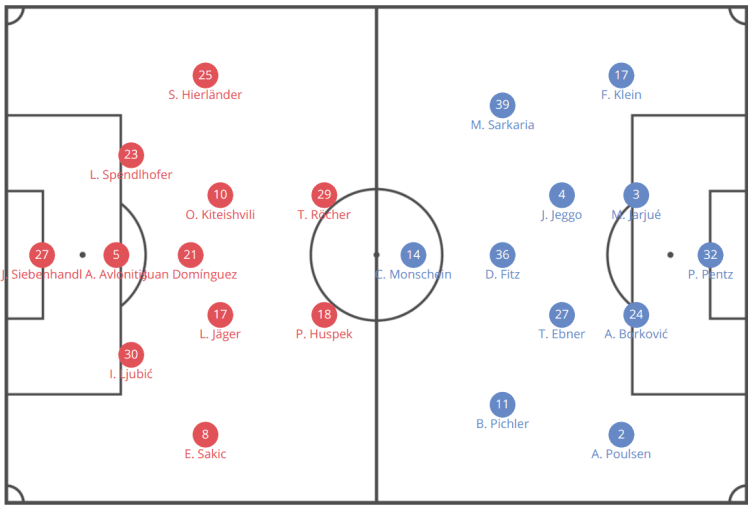
Austria Vienna’s flexible defensive approach
Before we start the actual tactical analysis, you had to admit that both teams were quite weak during the periods of possession in this game. On the one hand, both teams were extremely flexible and solid in their work against the ball but on the other, you just saw that (especially for Austria Vienna) it was an extremely important game as they had to win and due to that, they seemed a bit nervous.
We’ll now take a look at the periods of possession of Sturm Graz. While on the teamsheet ahead of the match it wasn’t clear how the three central midfielders would be positioned during the build-up in the game, it was until to the last 20 minutes of the match where they made three changes (as we’ll see later in this tactical analysis) clearly to a 3-1-4-2 as the wing-backs pushed forward while Domínguez was the deepest midfielder who supported the back-three during the first phase of the build-up.
Especially in the opening phase of the match, Austria Vienna executed an intense and high man-orientated pressing as Fitz was near Domínguez and the wingers joined Monschein in pressing the back three.
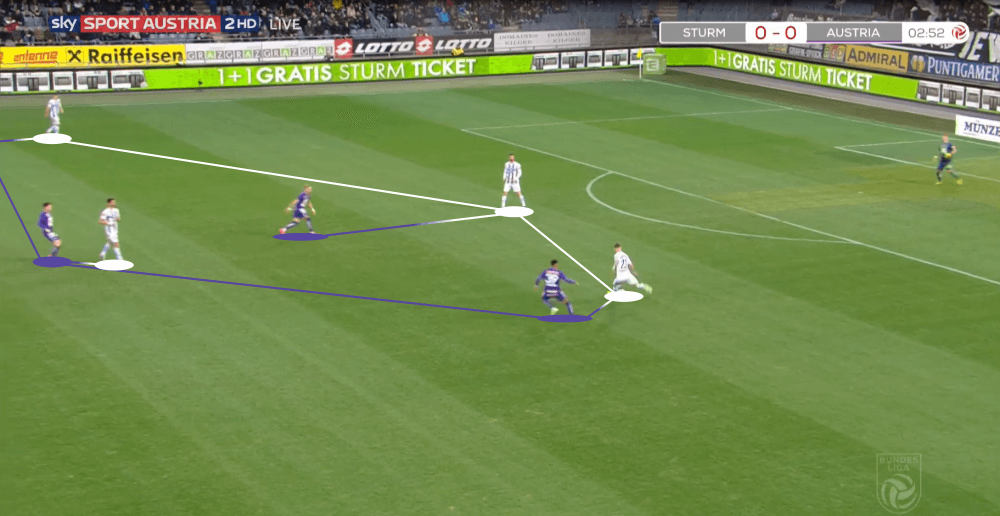
As the game went on, Ilzer’s squad switched between a high pressing and dropping back deeper. The press was especially high and man-orientated in the first minutes of the game while later they, especially the wingers Sarkaria and Pichler, stayed a bit deeper. Fitz was still near his Spanish opponent and the defensive midfielders were near Kiteishvili and Jäger but the wingers weren’t that aggressive, high, nor man-orientated. This was especially so with Pichler on the left side as we can see in the example below.
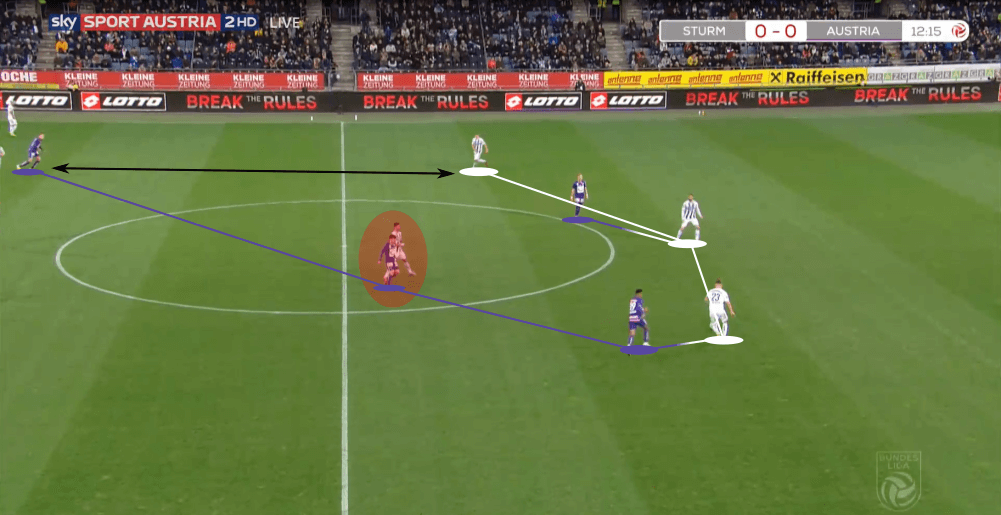
As above mentioned in this tactical analysis, the two defensive midfielders of Austria Vienna Ebner and Jeggo, were always near the two central midfielders of Sturm Graz. Now, this is nothing too surprising as these two formations create automatically quite a lot of one-on-one situations as you have in every area of the pitch the exact same number of players.
However, when you have players like Kiteisvili who love to have the ball at their feet and when their team needs their creativity, it’s interesting to see how they look for free spaces in such situations. The Georgian midfielder dropped several times deeper on Sturm’s left side to escape his marker, Ebner. Now, the question is how Ebner reacts in these situations since usually, that is the space which Sarkaria is occupying. In this game, Ebner and Jeggo mostly followed their opponents as well in these situations as we can see below.
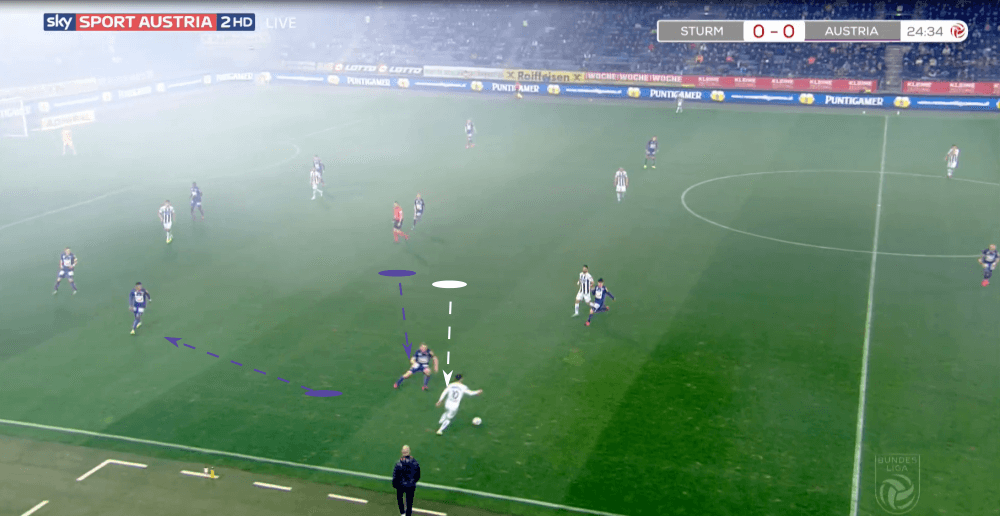
As already noted, Austria Vienna switched between the high pressing and sitting back deeper. When they defended deeper, we saw a quite similar approach compared to their tactics which they used one week ago against RB Salzburg as they stayed extremely compact and focused especially on the centre. In some situations, they were so horizontally compact that the wings were completely vacant, but Sturm never really made any use of that. They wanted to give Sturm Graz no chance to attack through the centre with their two banks of four while Fitz and Monschein were positioned higher
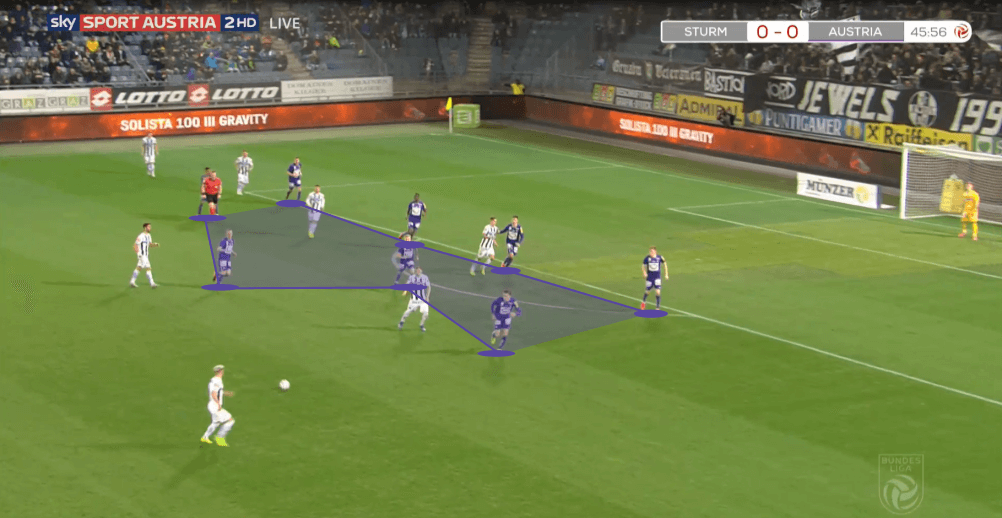
Sturm Graz’s defence
On the other side, we had Austria Vienna who clearly wanted to have a structured, calm and safe build-up as they wanted to avoid an early goal against them. Due to that, both defensive midfielders stayed deeper during the first phase of the build-up and supported the back four during the build-up. Klein and Poulsen positioned higher than the centre-backs but still were quite deep to provide them with additional passing options.
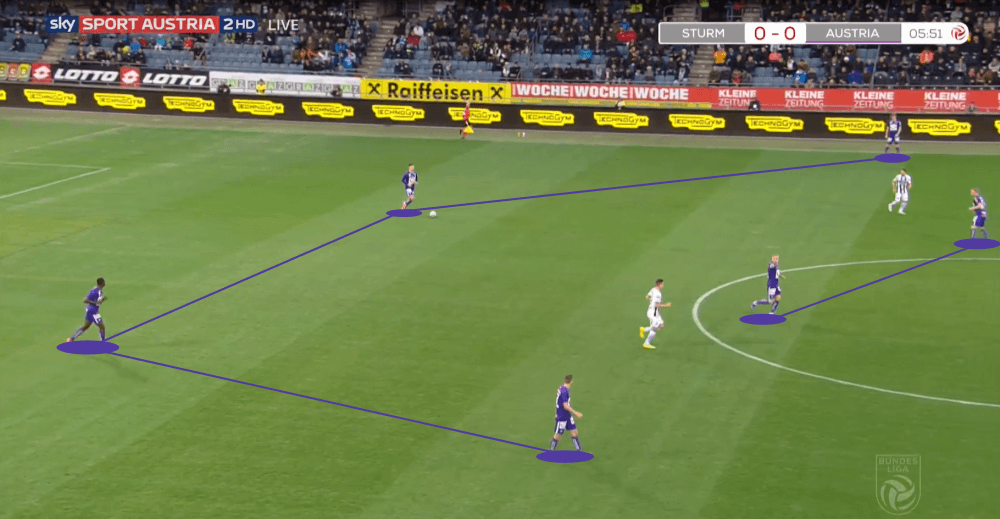
Sturm Graz also used high pressing which wasn’t that effective in the opening phase as Austria Vienna were able to bypass it in several situations. Huspek and Röcher tried to force the opposition to play the ball to one of the two full-backs Klein and Poulsen where then their wing-backs Hierländer and Sakic put pressure on them. In the example below, the two forwards provoke the passes to the right side of Austria Vienna where then Hierländer put pressure on Klein.
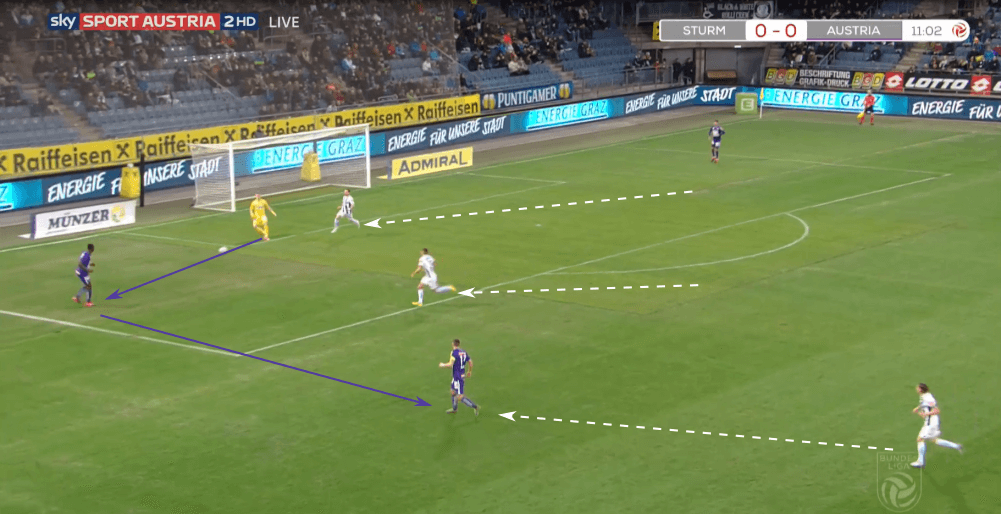
Also, while Fitz man-marked Domínguez during the periods when Sturm Graz were in possession, it was the other way around when Austria Vienna were on the ball as the Spaniard looked after the 20-year-old offensive midfielder who is one of the best players of the Veilchen this season.
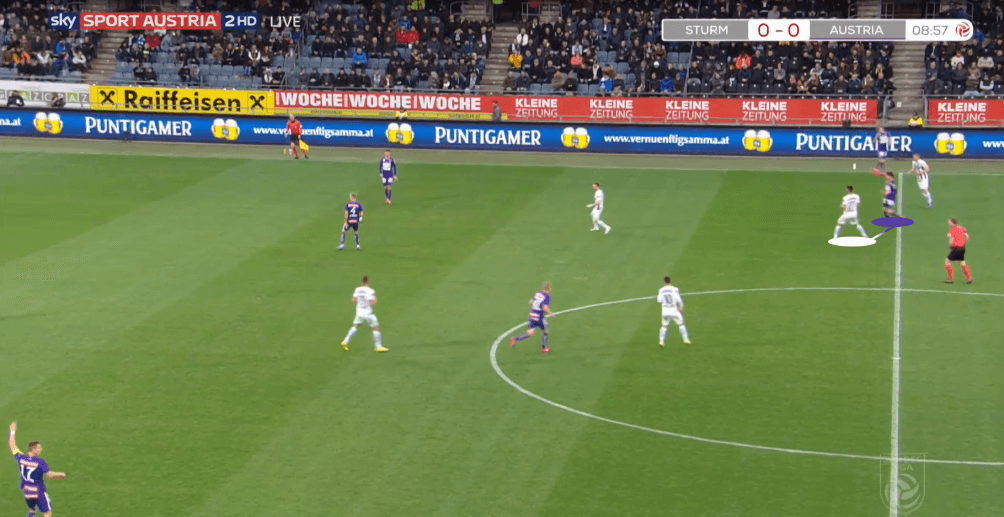
Since Fitz is usually quite important for the build-up of Austria Vienna as he is the one who provides his teammates vertical passing options through the centre, you clearly noticed that Ilzer’s team had problems whenever Domínguez marked the number 10 so tight that he was taken out of the game. In these situations, someone else had the task to be responsible for the progression of the ball and that person was the defensive midfielder Jeggo. The Australian moved in several situations cleverly into free spaces, no matter if it was during Graz’s press or when they sat back deeper. In the shot below we see a good example as Jeggo positions himself at the right moment in the free space to open up the passing lane towards him.
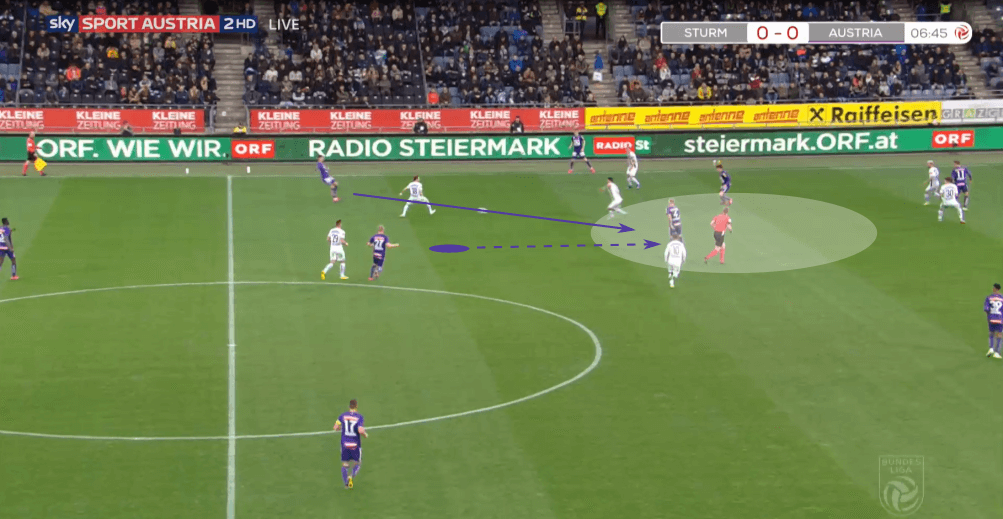
Benedikt Fitz and Christoph Monschein
In general, it has been a really disappointing season for Austria Vienna. Already ahead of this game, the team were rarely able to show good performances in this season and after this game, it is clear that they won’t be part of the championship group. Still, the performance and development respectively of Monschein and Fitz are clearly one of the most positive aspects of this whole season.
Monschein is one of the best goalscorers of the league with 15 goals and only Patson Daka, Erling Haaland, and Shon Weissman scored more often. Meanwhile, Fitz became one of the most important players of Austria Vienna even though he’s just 20 years old.
The big problem is that the Veilchen just scored 32 goals in the opening 20 games which means that Monschein is responsible for almost half of the goals. However, the Austrian forward isn’t a striker who permanently stays up front in the centre in the space near the opposing defenders, but instead likes to drop deeper or position wider to get on the ball more often. Anyways, the problem is that there is then almost nobody in the middle to receive crosses or through passes, as we can see in the two situations below in which Monschein drifts to the outside and drops deeper respectively to get involved.
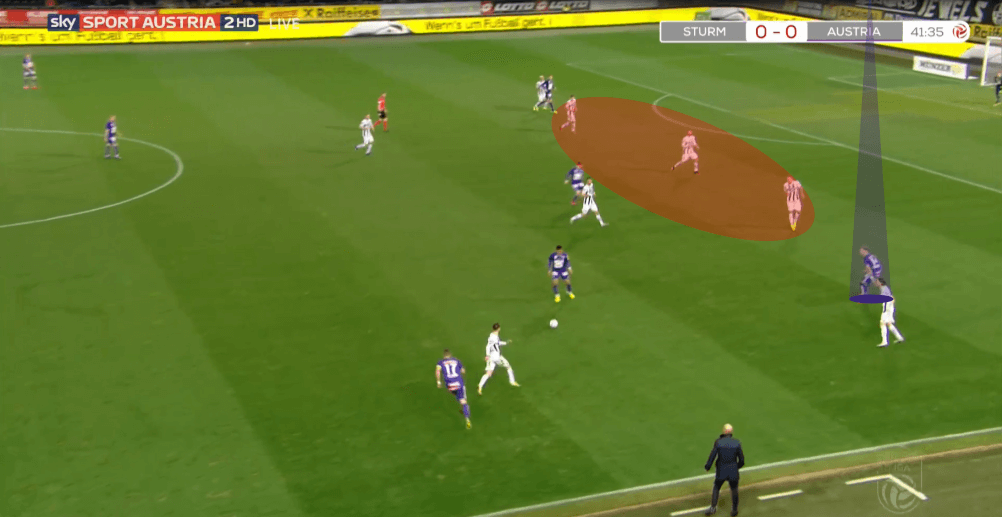
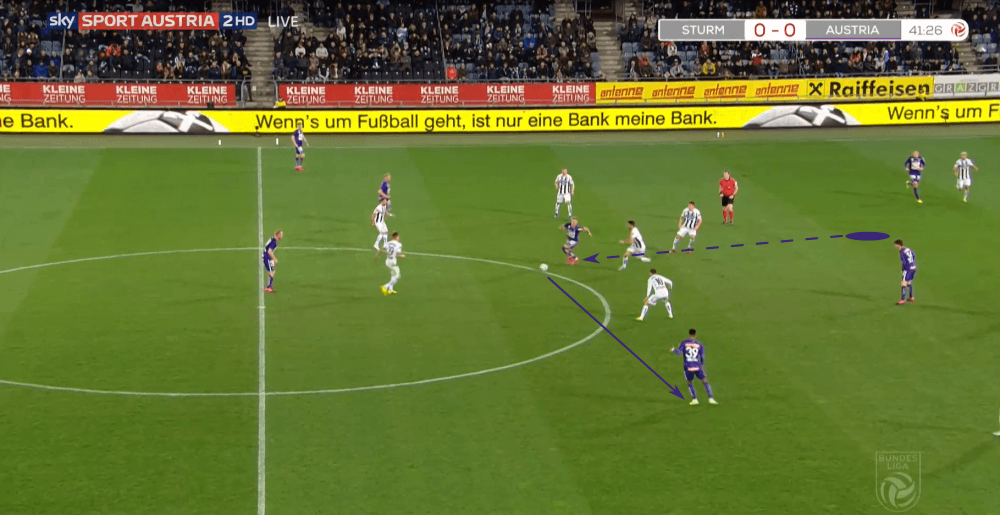
Meanwhile, we already saw in this tactical analysis that El Maestro’s plan to man-mark Fitz worked off quite well and you have to give credit to Domínguez who did a great job and took the young Austrian out of the game for the most time. However, especially in the second half, Fitz dropped deeper and acted during the build-up more like a defensive midfielder who organises the build-up and due to that, he escaped his marker. This was also one of the reasons for the 1-0 of Austria Vienna as Fitz once more positioned really deep to have space and the time to play long through ball towards Sarkaria who converted that pass with two touches into a beautiful goal.
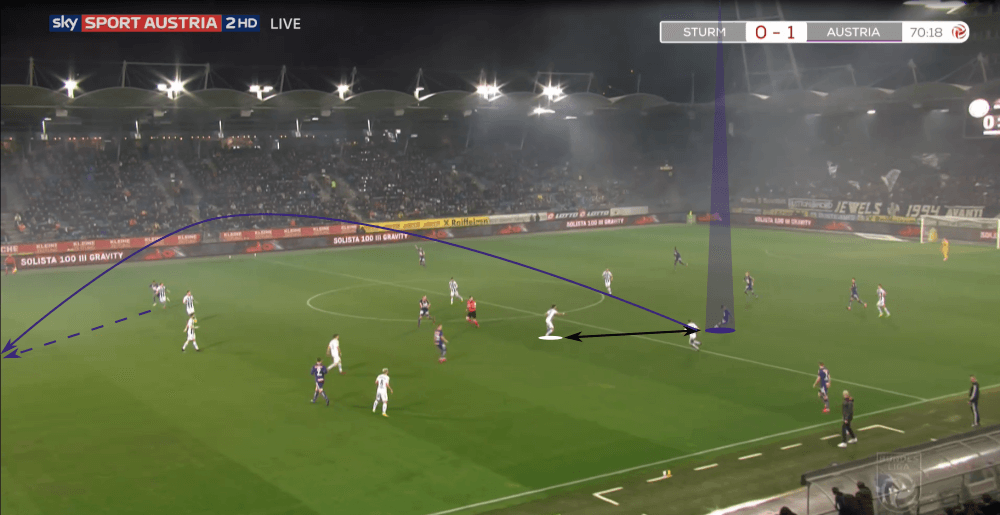
The substitutions save Sturm Graz
Austria Vienna scored the opening goal of this game in the 70th minute and meanwhile, it seemed as though Hartberg would lose against LASK Linz. Due to that, it was realistic that they would really get a chance on the 22nd matchday to get into the sixth position.
Logically, Sturm Graz wanted to get back into this game and avoid the defeat against Ilzer’s team. Due to that, El Maestro made three minutes after the 1-0 two changes and already seconds before the opening goal, brought on Jakob Jantscher for Huspek. After the goal, Bekim Balaj and Kevin Friesenbichler replaced Domínguez and Röcher.
The switched to a 3-4-1-2 formation with Friesenbichler and Balaj up front and Jantscher behind them. So, they had now three fresh men upfront and you instantly felt that they had more power up front.
In the end, these three players were responsible for the 1-1 in the 88th minute as Friesenbichler played a through ball to Jantscher who delivered a low cross which Balaj converted into a goal as we can see below.

Conclusion
All in all, it was clearly not the best game for each team in this season as they were both quite harmless. However, you have to give them credit for their defensive work. After this matchday, it is clear which six teams will fight for the championship and places in the UEFA Champions League and the UEFA Europa League.
Still, there is one more matchday left until the two teams will get divided into the two groups, but since Austria Vienna is now five points behind Hartberg, there is no chance anymore. Still, it will be interesting to watch how they will perform against the other five weakest teams of the Austrian Bundesliga and if Monschein and Fitz leave the club in the summer.





Comments